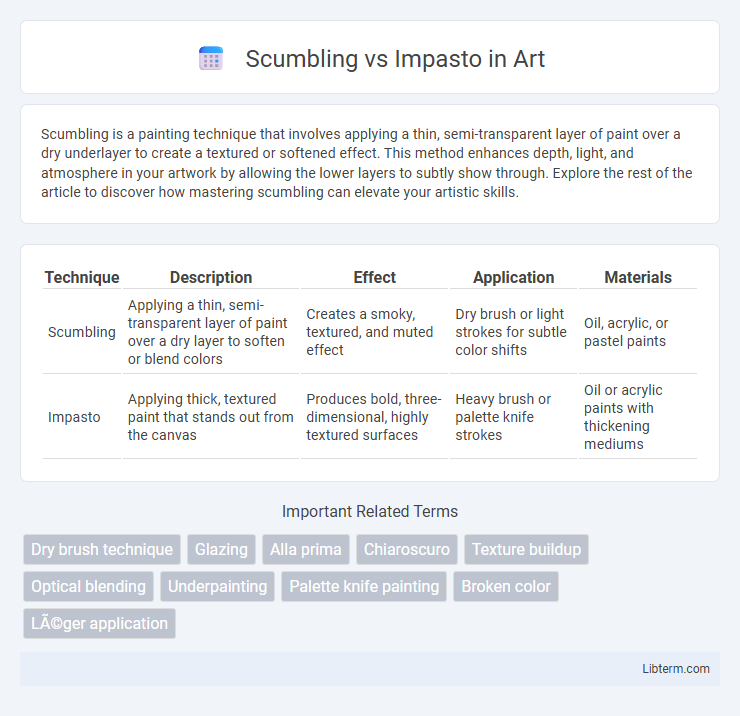Scumbling is a painting technique that involves applying a thin, semi-transparent layer of paint over a dry underlayer to create a textured or softened effect. This method enhances depth, light, and atmosphere in your artwork by allowing the lower layers to subtly show through. Explore the rest of the article to discover how mastering scumbling can elevate your artistic skills.
Table of Comparison
| Technique | Description | Effect | Application | Materials |
|---|---|---|---|---|
| Scumbling | Applying a thin, semi-transparent layer of paint over a dry layer to soften or blend colors | Creates a smoky, textured, and muted effect | Dry brush or light strokes for subtle color shifts | Oil, acrylic, or pastel paints |
| Impasto | Applying thick, textured paint that stands out from the canvas | Produces bold, three-dimensional, highly textured surfaces | Heavy brush or palette knife strokes | Oil or acrylic paints with thickening mediums |
Introduction to Scumbling and Impasto
Scumbling and impasto are two distinct painting techniques that create unique textural effects on a canvas. Scumbling involves applying a thin, semi-opaque layer of paint over a dry underlayer, allowing the underneath color to subtly show through and add depth. Impasto, in contrast, uses thickly applied paint to build texture and dimension, often conveying energy and movement through its raised surfaces.
Defining Scumbling: Technique and History
Scumbling is a painting technique where a thin, semi-transparent layer of lighter or muted color is brushed over a darker underlayer to create a textured, soft-focus effect. Originating from the Renaissance period, this method was perfected by artists seeking subtle tonal variations and depth without heavy paint application. Unlike impasto, which uses thick, raised layers of paint to add volume and texture, scumbling emphasizes light diffusion and visual complexity through delicate layering.
Understanding Impasto: Origins and Methodology
Impasto, originating from the Italian word for "dough" or "mixture," is a painting technique characterized by thick, textured layers of paint applied with palette knives or brushes. This method allows artists to create dimensional surfaces that capture and reflect light, enhancing the visual impact and emotional intensity of the artwork. Rooted in Baroque and Renaissance painting traditions, impasto emphasizes tactile quality and surface expressiveness, contrasting with the thin, smooth layers seen in scumbling.
Tools and Materials Needed for Each Technique
Scumbling requires dry, stiff brushes or palette knives to apply thin, broken layers of paint, often using opaque or semi-transparent colors to create textured effects. Impasto demands heavy-body paints and sturdy brushes or palette knives that can hold thick paint, allowing for pronounced, three-dimensional strokes. Both techniques benefit from using high-quality acrylics or oils, but impasto typically requires more paint and specialized mediums to maintain texture and volume.
Key Differences Between Scumbling and Impasto
Scumbling involves applying a thin, semi-transparent layer of paint to create a soft, textured effect that allows underlying colors to partially show through, emphasizing subtle tonal variations. Impasto uses thick, heavy paint application to build up a textured surface with pronounced brushstrokes or palette knife marks, adding a three-dimensional quality to the artwork. Scumbling is primarily about light modulation and softness, whereas impasto emphasizes physical texture and bold volume on the canvas.
Artistic Effects and Visual Outcomes
Scumbling creates a soft, textured effect by lightly dragging a dry, opaque paint layer over a dried surface, allowing underlying colors to subtly show through and producing a misty or atmospheric quality. Impasto involves applying thick, textured paint layers that stand out from the canvas, adding dimension and dramatic shadows, which enhance the tactile and expressive intensity of a painting. These contrasting techniques influence visual outcomes, with scumbling providing depth and luminosity through translucency while impasto emphasizes boldness and volume through pronounced texture.
Popular Artists Who Used Scumbling vs. Impasto
Scumbling, favored by artists like J.M.W. Turner and John Constable, creates soft textures and subtle tonal variations by applying thin, semi-transparent layers of paint. In contrast, impasto is prominently used by Vincent van Gogh and Rembrandt, characterized by thick, textured brushstrokes that add depth and intensity to the painting surface. These distinct techniques contribute to the unique visual effects and expressive qualities evident in the works of these master painters.
When to Choose Scumbling Over Impasto
Choose scumbling over impasto when you want to create subtle texture and soft transitions between colors without adding significant volume to the painting surface. Scumbling allows artists to build atmospheric effects and nuanced layers in oil or acrylic paintings, making it ideal for landscapes or delicate skin tones. This technique works best when a light, broken application of opaque or semi-opaque paint enhances underlying colors, whereas impasto emphasizes bold, sculptural texture through thick, textured paint.
Combining Scumbling and Impasto in One Artwork
Combining scumbling and impasto in one artwork creates dynamic texture contrasts by layering semi-transparent, thin scumbles over thick, bold impasto strokes. This technique enhances depth and visual interest, allowing artists to emphasize light diffusion through scumbling while maintaining the tactile richness of impasto. Mastering the balance between these methods results in a richly textured painting that showcases both subtlety and intensity in surface detail.
Tips for Beginners: Mastering Both Techniques
Beginners mastering scumbling should use a dry brush with minimal paint to create soft, textured layers that enhance depth without overpowering the canvas. For impasto, apply thick, heavy paint with a palette knife or brush to build bold, dimensional textures, ensuring the paint maintains body and shape. Experiment with layering scumbling over impasto to combine subtle color transitions with striking surface texture for dynamic artwork.
Scumbling Infographic

 libterm.com
libterm.com